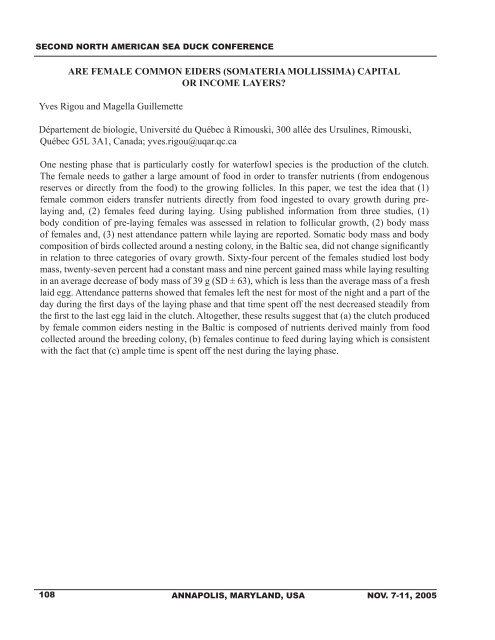Second North American Sea Duck Conference - Patuxent Wildlife ...
Second North American Sea Duck Conference - Patuxent Wildlife ...
Second North American Sea Duck Conference - Patuxent Wildlife ...
You also want an ePaper? Increase the reach of your titles
YUMPU automatically turns print PDFs into web optimized ePapers that Google loves.
SECOND NORTH AMERICAN SEA DUCK CONFERENCE<br />
ARE FEMALE COMMON EIDERS (SOMATERIA MOLLISSIMA) CAPITAL<br />
OR INCOME LAYERS?<br />
Yves Rigou and Magella Guillemette<br />
Département de biologie, Université du Québec à Rimouski, 300 allée des Ursulines, Rimouski,<br />
Québec G5L 3A1, Canada; yves.rigou@uqar.qc.ca<br />
One nesting phase that is particularly costly for waterfowl species is the production of the clutch.<br />
The female needs to gather a large amount of food in order to transfer nutrients (from endogenous<br />
reserves or directly from the food) to the growing follicles. In this paper, we test the idea that (1)<br />
female common eiders transfer nutrients directly from food ingested to ovary growth during prelaying<br />
and, (2) females feed during laying. Using published information from three studies, (1)<br />
body condition of pre-laying females was assessed in relation to follicular growth, (2) body mass<br />
of females and, (3) nest attendance pattern while laying are reported. Somatic body mass and body<br />
composition of birds collected around a nesting colony, in the Baltic sea, did not change significantly<br />
in relation to three categories of ovary growth. Sixty-four percent of the females studied lost body<br />
mass, twenty-seven percent had a constant mass and nine percent gained mass while laying resulting<br />
in an average decrease of body mass of 39 g (SD ± 63), which is less than the average mass of a fresh<br />
laid egg. Attendance patterns showed that females left the nest for most of the night and a part of the<br />
day during the first days of the laying phase and that time spent off the nest decreased steadily from<br />
the first to the last egg laid in the clutch. Altogether, these results suggest that (a) the clutch produced<br />
by female common eiders nesting in the Baltic is composed of nutrients derived mainly from food<br />
collected around the breeding colony, (b) females continue to feed during laying which is consistent<br />
with the fact that (c) ample time is spent off the nest during the laying phase.<br />
108 ANNAPOLIS, MARYLAND, USA NOV. 7-11, 2005












